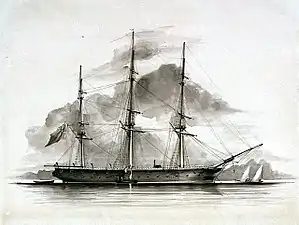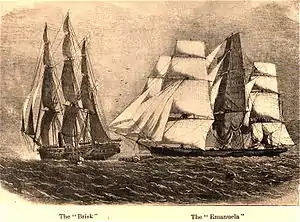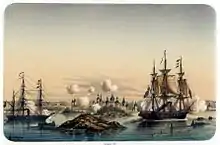HMS Brisk (1851)
HMS Brisk was a 14-gun wooden-hulled screw sloop of the Royal Navy, launched on 2 June 1851 from Woolwich Dockyard.[2] She served in the Crimean War and as part of the West African anti-piracy patrol, as well as during the New Zealand Wars. She was sold in 1870.
 Brisk, Capt A. F. R. de Horsey drawn in 1860 | |
| History | |
|---|---|
| Name: | HMS Brisk |
| Ordered: | 25 April 1847 |
| Builder: | Woolwich Dockyard |
| Cost: | £47,482[1][Note 1] |
| Laid down: | January 1849 |
| Launched: | 2 June 1851 |
| Completed: | 24 August 1853 at Devonport Dockyard |
| Commissioned: | 24 May 1853 |
| Decommissioned: | 19 January 1869 |
| Fate: | Sold on 31 January 1870 |
| General characteristics as built[1] | |
| Type: | Screw sloop (corvette from 1862) |
| Displacement: | 1,474 long tons (1,498 t) |
| Tons burthen: |
|
| Length: |
|
| Beam: | 35 ft (10.7 m) |
| Draught: | 13 ft 9 in (4.2 m) (mean) |
| Depth of hold: | 20 ft 5 1⁄2 in (6.2 m) |
| Installed power: |
|
| Propulsion: |
|
| Speed: |
|
| Armament: |
|

Construction
Ordered from Woolwich Dockyard on 17 February 1847 to the same design as Rattler, she was re-ordered as an enlarged version on 25 April 1847. She was laid down in January 1849 and launched on 2 June 1851.[1]
Service
North America and West Indies
She was sent to the North America and West Indies Station on 24 May 1853 under Commander Frederick Beauchamp Paget Seymour. Her task was to stop slave boats.
Crimean War
When war was declared she was sent on 27 March 1854 to participate in the White Sea blockading Arkhangelsk under Sir Erasmus Ommanney's squadron. Returning to England in spring of 1854 she was then sent operations on the Russian Pacific coast. She was under Commander Alfred John Curtis from 20 October. On 1 June 1855 the squadron entered the harbour of Petropavlovsk, but found it abandoned. The batteries and magazines were then destroyed. On 7 June an eruption of Kozelsky was witnessed.

Pacific Station
She was then assigned to the Pacific Station from 1854 until paying off at Plymouth on 13 June 1857.
Cape of Good Hope
From recommissioning on 5 May 1859 to the 24 February 1862, she served with the Cape of Good Hope Station under Captain Algernon Frederick Rous de Horsey. Apart from anti-slavery patrols, she also searched for Dr. Livingstone on 15 September 1859 at the River Kongone. In November she picked up the survivors of the Barretto Junior which had run aground on Mayotto Reef from Mayotto
On 10 August 1860 she captured the Manuella in the Mozambique Channel with more than 800 slaves aboard.[3]
West Africa
She was assigned in February 1862 to the West Africa Squadron under Captain John Proctor Luce until being paid off on 22 August 1863.
Australia and New Zealand
From October 1864 she was assigned to the Australia Station under Captain Charles Webley Hope. She was sent to relieve HMS Miranda. Sailing around the Cape of Good Hope, she arrived in Sydney on 15 January 1865. Once there she received orders to proceed immediately to New Zealand and join the squadron at Auckland. She arrived in Auckland on 5 February, with the Miranda departing the same day. The Brisk was to undertake escort duties during the New Zealand Wars.
Her first task was to take 300–400 troops of the 2nd Battalion, 14th Regiment, under Colonel W. C. Trevor from Manukau to Whanganui on 1 March 1865. Returning to Auckland she took Governor Grey to Kawau on 1 May. On 15 May she received news from the Dauntless of the demise of the clipper Fiery Star. She sailed for the Chatham Islands to search for the missing passengers and crew.[4] None were found and she returned to Auckland.
On 6 August she took 300 soldiers of the 70th Regiment from Taranaki to Napier and from there she was involved in the fighting around Opotiki. In early 1866 she took soldiers of the 43rd Regiment to Taranaki. After this she left Auckland and sailed around the south sea islands, returning to Sydney on 26 September for a refit. From 10 January to 3 May 1867 she took Governor Grey on a tour around New Zealand's South Island.
Fate
She was decommissioned on 19 January 1869 and lent on 31 January 1870 to the International Mid-channel Telegraph Company for commercial service.[2] Anchored some 60 miles of shore near Admiralty Patch, off Penzance Harbour in April 1870, the Brisk was part of an experimental telegraph service located at Porthcurno, Cornwall.[7][8][9] Cable breakages and sea-sickness amongst the signallers ended the venture after two months in June 1870.[10][11]
Notes
- A total cost accounting for inflation of approximately £5,237,200 in today's money.
Citations
- Winfield (2004), p.213.
- Bastock (1988), p.27.
- Benyon, P. (2013). "HMS Brisk". Naval Database. Retrieved 11 May 2015.
- "Cruise of HMS Brisk". The New Zealand Herald. II (484). 1 June 1865. p. 4.
- Davis, P. (2015). "HMS Brisk". William Loney RN. Retrieved 11 May 2015.
- "HMS Brisk". The New Zealand Herald. V (1513). 30 September 1868. p. 3.
- http://royalnavalmuseum.org/visit_cfimage_brisk.htm Archived 20 December 2010 at the Wayback Machine
- "Mid-ocean telegraph stations". Hawke's Bay Herald. 14 (1131). 1 March 1870. p. 5.
- "Shipping". South Australian Register. Adelaide, South Australia. 6 August 1870. p. 4.
- Glover, Bill (2015). "Cable Timeline: 1845-1900". History of the Atlantic Cable & Submarine Telegraphy. Retrieved 11 May 2015.
- Green, Allan (2004). "150 Years of Industry & Enterprise at Enderby's Wharf". History of the Atlantic Cable & Submarine Telegraphy. Retrieved 11 May 2015.
References
- Bastock, John (1988). Ships on the Australia Station. Frenchs Forest, Australia: Child & Associates Publishing Pty Ltd. ISBN 0-86777-348-0.
- Winfield, R.; Lyon, D. (2004). The Sail and Steam Navy List: All the Ships of the Royal Navy 1815–1889. London: Chatham Publishing. ISBN 978-1-86176-032-6.
External links
 Media related to HMS Brisk (ship, 1851) at Wikimedia Commons
Media related to HMS Brisk (ship, 1851) at Wikimedia Commons
